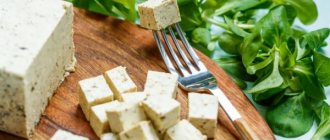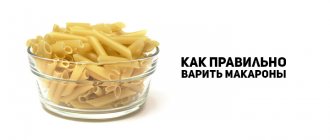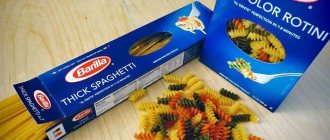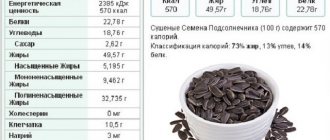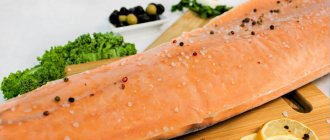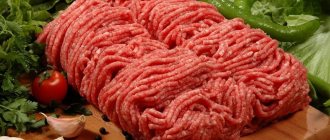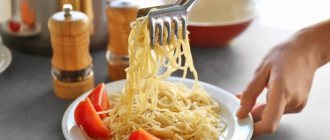In the usual understanding, any diet is inextricably linked with the need to give up many foods, which include pasta. This dish, which came to us from Italy, has become an integral part of the diet of most people, so giving it up even during a diet is not an easy task.
Those who have decided to get their figure in order, get rid of excess weight and find the strength to live, do not necessarily have to limit themselves to such a product as pasta. However, in this matter, strict adherence to measures and the selection of high-quality samples made exclusively from durum wheat are necessary.
Dietary properties:
What calorie content does spaghetti have, what dietary properties do they have? All this is of great interest to those who lead a healthy lifestyle and monitor their health and figure. So we will try to answer these questions in the next article.
So here it is:
Spaghetti, like almost all pasta, is an invention of the Italians, and what it is made from is no secret to anyone, since pasta dough usually contains only flour and water. Thin, round in cross-section, similar to sticks or ropes, they differ from pasta in that their length must be at least 25 cm, and their diameter is usually 2 mm. There are thicker ones - spaghettoni, and thinner spaghettini. But pasta is no different from spaghetti, since all pasta is called pasta.
For this type of pasta, durum wheat flour is used, so they are quite strong, do not break and are light yellow in color. Boil them in large saucepans in salted water, watching carefully and stirring so that they do not stick together or burn. The best degree of readiness is “al dente”, when they are almost ready, but not overcooked, but retain a pleasant elasticity on the teeth.
So, first of all, it should be noted that pasta is a source of energy for the human body. As you know, mainly plant foods are rich in slow carbohydrates, that is, those that do not lead to a rapid increase in blood sugar.
These carbohydrates are broken down in the human intestinal tract into glucose, and in this form they are absorbed into the blood. Then our pancreas synthesizes insulin, which leads to a decrease in blood glucose levels and the deposition of this glucose “in reserve” in the liver in the form of glycogen. Further, the glycogen supply will be consumed for the successful functioning of the human body.
The second useful feature of this product is its very low fat content. Consequently, its use does not lead to the deposition of cholesterol in the blood vessels, which subsequently leads to atherosclerosis, which is in first place among the causes of mortality!
About choosing a useful product
In order for the paste to bring maximum benefits to the body, you need to know the rules for choosing the product in question.
For this, the following factors are taken into account:
- it is important to pay attention to the instructions, where the KBZHU is written - the content of calories, proteins, fats and carbohydrates - in pasta recommended for weight loss there should be at least 10 g of protein per 100 g;
- good pasta is sold only in packages;
- the color should not be bright - this indicates the use of dyes;
- if there are white specks on the surface, it means that the purchase is rejected - this is low-quality flour that did not dissolve during the process of kneading the dough;
- a musty smell indicates improper storage of the product - it should not be consumed;
- packaging with pasta must be a sealed transparent plastic bag (it is important to be able to independently examine the contents of the bag);
- during cooking the pasta, no foam should form on the surface, the water should be clear, without additional shades;
- the cost of a quality product is above average.
The choice of form and manufacturer is carried out at your own discretion and financial capabilities.
Please note: Pasta produced by Makfa and Barilla are especially popular. The first one is affordable for most buyers. Barilla products are somewhat more expensive. Both offer durum wheat pasta.
Spaghetti Ingredients:
Vitamins:
| Vitamin: | IN 1 | AT 2 | AT 4 | AT 5 | AT 6 | AT 9 | RR | E |
| in mg. per 100 grams | 0.16 | 0.07 | 16.0 | 0.6 | 0.2 | 0.007 | 1.00 | 0.45 |
Minerals:
| Mineral: | Calcium | Phosphorus | Magnesium | Potassium |
| in mg. per 100 grams | 22 | 133 | 45 | 66 |
Spaghetti, in addition, contains very little protein, which, of course, is not enough for the daily functioning of the body, but, at the same time, more than 10 grams. protein per 100 grams. this product. There are also types of this pasta, which include a larger amount of protein - there will be more than 20 grams of it. per 100 gr. product.
Calorie content of spaghetti
On the one hand, the calorie content of spaghetti is high - approximately 345 kilocalories (Kcal) per 100 grams. On the other hand, spaghetti is a product with a low fat content (about 1 gram), an average protein content (about 10 grams) and a high carbohydrate content (more than 70 grams) per 100 product. It turns out that as a vegetable product (and spaghetti is usually made from wheat flour), spaghetti contains almost no fat, which means that the calorie content will only be less. On the other hand, the very high carbohydrate content makes spaghetti a high-calorie product. However, it is possible not only to eat spaghetti, not only to benefit from it, but also to lose weight.
How many calories are in spaghetti?
Here's how much:
Naturally, the calorie content of spaghetti depends on the type and method of preparation.
Pay attention to this table:
Spaghetti calorie table and nutritional value (BJU) per 100 grams:
| Spaghetti: | Bel, gr. | Fat, gr. | Angle, gr. | Cal, kcal. |
| Dry | 8.0 | 0.8 | 39.8 | 186 |
| Boiled | 3.5 | 0.4 | 23.2 | 112 |
| Bolognese | 9.5 | 8.1 | 19.0 | 190 |
| Boiled Bolognese | 3.8 | 0.8 | 14.0 | 114 |
| Barilla | 14.0 | 2.0 | 70.0 | 359 |
| Boiled Barilla | 3.4 | 0.4 | 23.0 | 112 |
| With cheese | 5.1 | 3.7 | 18.1 | 127 |
| With butter | 3.7 | 4.2 | 28.0 | 171 |
| With vegetables | 4.5 | 0.1 | 22.3 | 128 |
| With tomato sauce | 3.5 | 13.5 | 22.5 | 224 |
Types of spaghetti
The spaghetti museum, as already mentioned, contains about two hundred types of this product. However, the main groups available to the consumer are the following:
- classic. Their length is 15-25 cm and diameter 1.8-2 mm;
- spaghettini, or small spaghetti. The length of this product is identical to the first, but the diameter is 1.4-1.8 mm;
- spaghettoni. They are thicker than classic ones, and their diameter is 2-2.2 mm.
An interesting type of spaghetti is considered to be extra spaghetti. This product has an incredible length for a pasta product. Initially, all spaghetti was prepared up to 50 cm long. But cooks and culinary specialists decided that this length was inconvenient for the product, and it needed to be reduced. Now the standard spaghetti is considered to be 25 centimeter pasta. However, many connoisseurs of tradition did not want to give up the famous extra-long ropes, and 50-centimeter copies were saved as a special format. But whatever the length or thickness of the product, the composition of spaghetti remains the same. And the dietary qualities of this product themselves are somewhat different from those of other pasta products.
Spaghetti for weight loss:
And further:
Pasta (noodles, cones, shells, spaghetti and others) are valuable because they contain protein, carbohydrates, a lot of fiber, B vitamins, vitamin E, trace elements iron, phosphorus and magnesium.
This composition allows a person not to experience hunger, not to suffer from depression and insomnia, as with other strict diets, and ensures good performance and mood during the day.
However, nutritionists recommend that when purchasing in a store, first of all, carefully study the product label. Only products made from durum wheat have the listed properties. You need to know that the signs of high quality are:
- matte, rough surface without a whitish flour coating,
- small black dots, like traces of grains.
Decoding information on packages
When losing weight, you should not buy pasta that contains the following components:
- Synthetic flavors.
- Salt.
- Traces of dairy products such as milk or whey.
- Eggs.
- Artificial colors and preservatives.
Additives such as paprika powder, natural tomato or spinach do not pose a threat to health and can be used in the diet. The packaging must contain the inscription “durum”, “durum wheat”, “group A” or “1st class”. Unlike pasta made from soft varieties, durum spaghetti bends perfectly and is quite durable. In order to break them, you need to make some effort.
Vitamins in Pasta made from premium flour
Pasta made from premium flour contains the following vitamins: Mono- and disaccharides, SFA - Saturated fatty acids, Ash, Starch, Water, Dietary fiber, Sodium, Potassium, Phosphorus, Magnesium, Calcium, Sulfur, Copper, Silicon, Iodine, Manganese, Chromium, Fluorine, Molybdenum, Cobalt, Zinc, Iron, Chlorine.
| Vitamin | Meaning |
| Vitamin B1 (thiamine), mg | 0,17 |
| Vitamin B2 (riboflavin), mg | 0,04 |
| Vitamin B6 (pyridoxine), mg | 0,16 |
| Vitamin B9 (folic), mcg | 20 |
| Vitamin E (TE), mg | 1,5 |
| Vitamin PP (Niacin equivalent), mg | 2,9 |
| Choline, mg | 52,5 |
| Vitamin B5 (pantothenic), mg | 0,3 |
| Vitamin PP, mg | 1,2 |
| Vitamin H (biotin), mcg | 2,02 |
| Vitamin E, mg | 2,1 |
Of the fat-soluble vitamins, the noodles contain E and K. Of the water-soluble vitamins, there are vitamins B1, B2, B3 (PP), B5, B6 and B9.
| Vitamins, content | Share of the daily norm for 100 g | |
| Vitamin A | 0.0 µg | 0,0% |
| Beta carotene | n/a | 0,0% |
| Alpha carotene | n/a | 0,0% |
| Vitamin D | 0.0 µg | 0,0% |
| Vitamin D2 | n/a | 0,0% |
| Vitamin D3 | n/a | 0,0% |
| Vitamin E | 0.1 mg | 0,8% |
| Vitamin K | 0.1 mcg | 0,1% |
| Vitamin C | 0.0 mg | 0,0% |
| Vitamin B1 | 0.1 mg | 7,5% |
| Vitamin B2 | 0.1 mg | 4,6% |
| Vitamin B3 | 1.7 mg | 10,6% |
| Vitamin B4 | n/a | 0,0% |
| Vitamin B5 | 0.4 mg | 8,6% |
| Vitamin B6 | 0.1 mg | 10,9% |
| Vitamin B9 | 18.0 mcg | 4,5% |
| Vitamin B12 | 0.0 µg | 0,0% |
How much protein is in pasta? How much protein is in durum pasta?
- Macaroni (pasta) is very tasty and healthy if prepared and served correctly. They are best served with pasta (I would say this is a classic), you can serve them with olive oil, with cheese, with vegetables, it will be very tasty with tuna. In addition, even if the pasta is of the highest quality, but from a different manufacturer, it has different calorie content. This is important to take into account for those people who eat a healthy diet and count the calories they eat. By the way, the amount of protein in pasta depends on the manufacturer, technology and, of course, the cooking recipe itself. The leading positions in many summary calorie tables (read on the Internet) are given to Italian pasta. The amount of protein in them ranges from 12 to 14 grams per hundred grams of product. This is very good and suggests that this pasta is not only incredibly nutritious, but also very tasty.
Russian manufacturers are a little behind and offer durum pasta with a nutritious protein content of around 10.4 - 10.7 grams per hundred grams of product.
- Different manufacturers estimate the content of this very protein differently...attributing to themselves the merits of others...getting carried away by production indicators...inventing who knows what...but in general everyone agrees on the figure of 10-12%
info-4all.ru
Compound
Pasta made from durum wheat contains less starch and more gluten than products made from soft wheat.
Therefore, the former have practically no negative impact on the figure, which cannot be said about the latter. In addition, high-quality pasta contains vitamin B, which helps the brain function properly and improves the condition of hair and skin. They also contain useful fiber, which restores the functioning of the digestive system.
On a note! Most of the calories the human body receives after eating a serving of pasta are contained not in the dough products themselves, but in sauces and gravies. It’s no secret that many people eat spaghetti or noodles with butter, mayonnaise, ketchup and other additives.
Calories and nutritional value of Spaghetti
Pasta made from premium flour contains the following elements: Mono- and disaccharides, SFA - Saturated fatty acids, Ash, Starch, Water, Dietary fiber, Sodium, Potassium, Phosphorus, Magnesium, Calcium, Sulfur, Copper, Silicon, Iodine, Manganese, Chromium, Fluorine, Molybdenum, Cobalt, Zinc, Iron, Chlorine.
| Micro and macro element | Meaning |
| Mono- and disaccharides, g. | 2 |
| SFA - Saturated fatty acids, g. | 0,2 |
| Zola, Mr. | 0,5 |
| Starch, Mr. | 67,7 |
| Water, city | 13 |
| Dietary fiber, g. | 3,7 |
| Sodium, mg | 3 |
| Potassium, mg | 123 |
| Phosphorus, mg | 87 |
| Magnesium, mg | 16 |
| Calcium, mg | 19 |
| Sulfur, mg | 71 |
| Copper, µg | 700 |
| Silicon, mg | 4 |
| Iodine, mcg | 1,5 |
| Manganese, mg | 0,577 |
| Chromium, µg | 2,2 |
| Fluorine, mcg | 23 |
| Molybdenum, mcg | 12,6 |
| Cobalt, µg | 1,6 |
| Zinc, mg | 0,708 |
| Iron, mg | 1,6 |
| Chlorine, mg | 77 |

